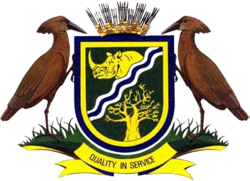
Great Zimbabwe is a medieval city in the south-eastern hills of the modern country of Zimbabwe, near Lake Mutirikwe and the town of Masvingo. It is thought to have been the capital of a kingdom during the Late Iron Age. Construction on the city began in the 11th century and continued until it was abandoned in the 15th century. The edifices were erected by ancestors of the Shona people, currently located in Zimbabwe and nearby countries. The stone city spans an area of 7.22 square kilometres (2.79 sq mi) and could have housed up to 18,000 people at its peak, giving it a population density of approximately 2,500 inhabitants per square kilometre (6,500/sq mi). It is recognised as a World Heritage Site by UNESCO.

Kruger National Park is a South African National Park and one of the largest game reserves in Africa. It covers an area of 19,623 km2 (7,576 sq mi) in the provinces of Limpopo and Mpumalanga in northeastern South Africa, and extends 360 km (220 mi) from north to south and 65 km (40 mi) from east to west. The administrative headquarters are in Skukuza. Areas of the park were first protected by the government of the South African Republic in 1898, and it became South Africa's first national park in 1926.

The Uluburun Shipwreck is a Late Bronze Age shipwreck dated to the late 14th century BC, discovered close to the east shore of Uluburun, Turkey, in the Mediterranean Sea. The shipwreck was discovered in the summer of 1982 by Mehmed Çakir, a local sponge diver from Yalıkavak, a village near Bodrum.

Thohoyandou is a town in the Limpopo Province of South Africa. It is the administrative centre of Vhembe District Municipality and Thulamela Local Municipality. It is also known for being the former capital of the bantustan of Venda.
The Kingdom of Mapungubwe was a medieval state in South Africa located at the confluence of the Shashe and Limpopo rivers, south of Great Zimbabwe. The name is derived from either TjiKalanga and Tshivenda. The name might mean "Hill of Jackals" or "stone monuments". The kingdom was the first stage in a development that would culminate in the creation of the Kingdom of Zimbabwe in the 13th century, and with gold trading links to Rhapta and Kilwa Kisiwani on the African east coast. The Kingdom of Mapungubwe lasted about 80 years, and at its height the capital's population was about 5000 people.

Arikamedu is an archaeological site in Southern India, in Kakkayanthope, Ariyankuppam Commune, Puducherry. It is 4 kilometres (2.5 mi) from the capital, Pondicherry of the Indian territory of Puducherry.

The Mapungubwe Collection at the University of Pretoria Museums comprises archaeological material excavated by the University of Gauteng at the Mapungubwe archaeological site since its discovery in 1933. The archaeological collection comprises ceramics, metals, trade glass beads, indigenous beads, clay figurines, and bone and ivory artefacts as well as an extensive research collection of potsherds, faunal remains and other fragmentary material. The University of Gauteng established a permanent museum in June 2000, thereby making the archaeological collection more widely available for public access and interest beyond the confines of academia. The collection is kept on site for tourism purposes.

The Vhembe District Municipality is one of the 5 districts of the Limpopo province of South Africa. It is the northernmost district of the country and shares its northern border with the Beitbridge District in Zimbabwe and on the east with the Gaza Province in Mozambique. Vhembe consists of all the territories that were part of the former Venda Bantustan; however, two large densely populated districts of the former Tsonga homeland of Gazankulu, in particular, Hlanganani and Malamulele, were also incorporated into the municipality, hence the ethnic diversity of the district. The seat is Thohoyandou, the capital of the former Venda Bantustan. According to 2011 census, the majority of the municipality's 800,000 inhabitants spoke TshiVenda as their mother language, while 400,000 spoke Xitsonga as their home language. However, the Tsonga people form the majority south of the Levubu River, while the Venda are the minority south of Levubu at 15%. The Sepedi speakers number 27,000. The district code is DC34.

The Venḓa are a Southern African Bantu people living mostly near the South African-Zimbabwean border. The Venda language arose from interactions with Sotho-Tswana and Kalanga initiates during the 15th century in Zimbabwe.

Ing'ombe Ilede is an archaeological site located on a hill near the confluence of the Zambezi and Lusitu rivers, near the town of Siavonga, in Zambia. Ing'ombe Ilede, meaning "a sleeping cow", received its name from a local baobab tree that is partially lying on the ground and resembles a sleeping cow from a distance. The site is thought to have been a small commercial state around the 16th century whose chief item of trade was salt. Ing'ombe Ilede received various goods from the hinterland of south-central Africa, such as, copper, slaves, gold and ivory. These items were exchanged with glass beads, cloth, cowrie shells from the Indian Ocean trade. The status of Ing'ombe Ilede as a trading center that connected different places in south-central Africa has made it a very important archaeological site in the region.
The Makuleke Contractual Park or Pafuri Triangle constitutes the northernmost section of the Kruger National Park, South Africa, and comprises approximately 240 square kilometres of land. The "triangle" is a wedge of land created by the confluence of the Limpopo and Luvuvhu Rivers at the tripoint Crook's Corner, which forms a border with Zimbabwe along the Limpopo River. It is a natural choke point for wildlife crossing from North to South and back, and forms a distinct ecological region.

The Kalanga or BaKalanga are a southern Bantu ethnic group mainly inhabiting Matebeleland in Zimbabwe, northern Botswana, and parts of the Limpopo Province in South Africa.
Malamulele can refer to the town of Malamulele or the area of Malamulele. Both the town and area are in the Limpopo province of South Africa and predominantly occupied by Tsonga people. Malamulele town has one provincial road and one regional road; the R81 to Giyani and the R524 to Thohoyandou respectively. Malamulele is flanked by two rivers, Levubu River (Rivhubye) to the west and Letaba River to the east, meanwhile the Shingwedzi River runs from Malamulele West to Malamulele East, joining the Olifants in Mozambique on its way to the Indian Ocean. Malamulele is the seat of the Collins Chabane Local Municipality.

Shingwedzi is a rest camp and ranger's post situated in the northern section of the Kruger National Park. The camp is located on the southern bank of the Shingwedzi River, for which it is named, in Limpopo province, South Africa. The surrounding country formerly constituted the Singwitsi Reserve, proclaimed in 1903, which encompassed over 5,000 square kilometers. The region was over-hunted by the end of the 19th century, its big game depleted and its elephant population completely decimated. The name "Shingwedzi" is of Tsonga origin, and was perhaps derived from "Shing-xa-goli", perhaps a local chieftain, and "njwetse", the sound of iron rubbing against iron.
Saruq Al Hadid is an archaeological site in Dubai, United Arab Emirates (UAE), and stands as one of the most important and enigmatic historical sites in the country. Findings from the site are displayed in a museum with the same name in the city of Dubai. The site was originally discovered by the ruler of Dubai, Sheikh Mohammed bin Rashid Al Maktoum, while flying his helicopter across the desert.
The Kalanay Cave is a small cave located on the island of Masbate in central Philippines. The cave is located specifically at the northwest coast of the island within the municipality of Aroroy. The artifacts recovered from the site were similar to those found to the Sa Huynh culture of Southern Vietnam. The site is part of the "Sa Huynh-Kalanay Interaction Sphere" which was an Iron Age maritime trading network associated with the Austronesian peoples of the Philippines, Vietnam, Taiwan, as well as most of northeastern Borneo and Southern Thailand. The type of pottery found in the site were dated 400 BC to AD 1500. The "Sa Huynh-Kalanay Interaction Sphere" is characterized by a remarkable continuity in trade goods, including decorated pottery and double-headed pendants and earrings known as lingling-o.

Leopard's Kopje is an archaeological site, the type site of the associated region or culture that marked the Middle Iron Age in Zimbabwe. The ceramics from the Leopard's Kopje type site have been classified as part of phase II of the Leopard's Kopje culture. For information on the region of Leopard's Kopje, see the "Associated sites" section of this article.
Ntusi is a Late Iron Age archaeological site located in southwestern Uganda that dates from the tenth century to the fifteenth century AD. Ntusi is dominated by two large mounds and manmade scraped valley basins called, bwogero. Long abandoned by the time Hima herdsman grazed their cattle on the Bwera, the herdsman named the site "Ntusi" meaning, "the mounds", after the prominent earthworks. The archaeological record at Ntusi is unmistakable in the signs of intense occupation and activity and it represents the beginning of political complexity in this region of Africa. Bigo bya Mugenyi, another site with prominent earthworks, lies 13 km to the north of Ntusi.
Bosutswe is an archaeological site at the edge of the Kalahari Desert in Botswana on top of Bosutswe Hill. The site can be dated back to around 700 AD. The location of Bosutswe makes it easy for archaeologists to study as the record of the site is continuous. It is believed that the area was occupied consistently for around 1000 years. It was known for its advanced metalworking which first appeared around 1300 AD, which is known as the Lose Period. The Lose Period is named after the elite class that can be found in the area.
Prohear is an archaeological site from the Early Iron Age located in the Prey Veng province of Cambodia between the capital city of Phnom Penh and the border with Vietnam. By the time the site became known to archaeologists in 2007, it had been heavily looted and few archaeological materials remained. Prohear is known for its burials and uniquely rich array of grave goods including numerous precious metal artifacts. A number of the artifacts excavated at the site have contributed to the study of trade routes that connected Prohear to the rest of Southeast Asia.













